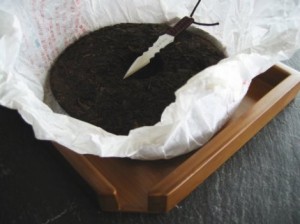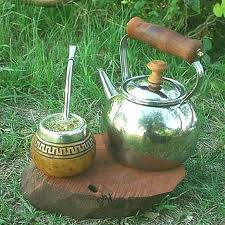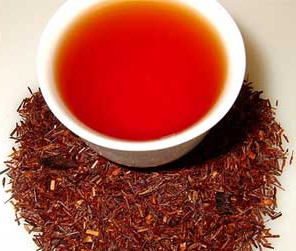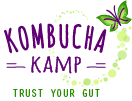
This is a follow up to the previous post:
“Tea & Kombucha – What to Use & What to Avoid”
Although Kombucha thrives best in a nutrient solution of straight tea and sugar, the advanced brewer is highly encouraged to experiment by using other herbal infusions to ferment the culture. One of the many benefits to this type of experimentation is that you receive far great health benefits from herbs that have been “pre-digested” through the fermentation process with the Kombucha culture. Basically, Kombucha grabs the healthful elements (polyphenols, sterols, anti-oxidants, etc) and starts breaking them down into a form that is more bio-available; that is, easier for the human body to absorb and make use of immediately. Try these types of experiments once you have a stash of back-up cultures in your SCOBY Hotel.
PU-ERH TEA

Pu-erh tea leaves are pressed into “cakes” and allowed to ferment in underground caves. It is a “living” tea due to the natural microbial activity from the fermentation process.
Pu-erh (AMZ) is a member of the tea family (camellia sinensis). An ancient 1700-year old tea tree lives in the mountains of Yunnan, the province in China where Pu-erh County, the namesake of the tea, is located. The locals have closely guarded their secrets in producing this highly prized tea that can range in price from a few dollars to thousands per ounce. It undergoes a special fermentation process which imbues specific healing properties i.e. lowering cholesterol and aiding weight loss. It is known as a “living” tea because the natural microbes present on the tea leaves at the time of picking are allowed to ferment the leaves in what is known as post-fermentation.
Located on the “茶馬古道” (Chámă Gŭdaò – tea horse ancient road), which served as an export road for horses from Tibet to China and tea from China to the Tibetans, Indians & beyond, Pu-erh County was a key stop along the path. Tibetans had little to no vegetables in their diet and the nutrients from the tea, which they soak in butter and drink to this day, helped fill that nutrition gap. The road took traders through treacherous terrain, crossing deep gorges on rope bridges and was seldom undertaken alone. Several outposts cropped up along the way to service the traders. The 茶馬古道 was at its height in the Song Dynasty (宋朝 960-1279) when 2000 or more travelers a day would carry over 7500 tons of tea out of China. Quite an amazing feat when you consider they did all this on foot! Besides tea, culture and Buddhism also spread in both directions thus influencing the philosophical development of future generations of Chinese thinkers.
Bonus Reading: The complete fascinating story of The Ancient Tea Horse Road crossing China into Tibet.
A Legend of Pu-Erh Tea
The process to creating the finest pu-erh tea is shrouded in mystery. To this day, many of the famous pu-erh tea plantations closely guard their techniques for cultivating this uniquely fermented tea. One legend states that monks took to burying their tea cakes to prevent them from being stolen by marauders. When they came back to uncover the tea, they discovered that it had undergone a transformation into what we now know as pu-erh tea. It was often pressed into lucky shapes such melons, mushrooms or in the shape of coins which made it easy to use as currency. To this day, decades old pu-erhs are highly prized and treated as investments similar to investing in fine French wines of a particular year.
The flavor of pu-erh tea is much more mild and fragrant than its appearance would seem to suggest. The first time I tried it, I was expecting a more robust flavor but was pleasantly surprised by its natural sweetness. Add some pu-erh to your tea blend to increase the body’s ability to deal with fatty foods, lower cholesterol and to help lose weight. In China, pu-erh is considered a medicinal tea and only drunk when required by one’s physical state of health. This makes it a great companion to the Kombucha’s natural healing properties.
YERBA MATE

Gourds are often carved with intricate designs and are prized possessions.
I first discovered Yerba Mate when one of the founders of Guayaki shared with me the ritual of the gourd. We were at a restaurant convention and though the place was packed with curious restauranteurs eager to gobble up or gulp any sample set before them, David spotted a kindred soul (I’m sure of it!) and passed on the ritual of drinking yerba mate. Yerba is the Argentinian variant for the Spanish word “hierba” meaning grass or herb. Mate comes from the Quechuan word for the gourd out of which the yerba is drunk, mati; literally, “herb cup.” Now, I share this gift with you!
The ritual starts when the cerbador (server) prepares the yerba mate to be drunk. First, a portion of dried stems and leaves are added to the gourd with some cold water to protect the nutrients and prevent scalding. When the mate has absorbed the water, then hot water (not boiling) is poured in the gourd. The cerbador will usually drink the first 1-2 rounds of “washings” to make sure the temperature is right and that it is running smoothly. Plus it gives them the energy to play host!
Then, the mate is offered to each friend with the bombilla (metal straw) facing the recipient. The cerbador looks the receipient in the eyes as they exchange the gourd. Only when the drinker has had their fill of mate will they then say gracias (thank you.) After each mate has been drunk, the cerbador adds a fresh supply of hot water and shares it with the next in the circle of friends. The yerba mate can be brewed several times, making it ideal for sharing with others. As they say, “We share the gourd, not the beverage.”
I was immediately taken with this ritual. It is so much about building community and connecting to others in a positive and sharing way. Friends gather to enjoy the mati and conversate about all manner of topics – a habit many people have lost thanks to the boob tube. There is an additional bonus to this communal sharing of the bombilla and mate; inoculation due to shared saliva. Basically, by swapping spit with friends, each person is inoculated to different viruses thereby building immunity. In our germophobic society, that might seem gross, but it is theorized that even kissing was developed to spread germs.
OK, back to the mate. My husband and I engaged in this ritual quite frequently while spending many long hours building the new website. My favorite part of this ceremony is when you look into each others eyes. So often these days, people avoid direct eye contact. Part of building community, is also building a safe place for that community to exist. Looking each other in the eye, sharing the same gourd and engaging in stimulating conversation is the perfect way to draw others into your circle of trust.
Yerba mate’s benefits extend beyond the ritual to the plant itself. Ilex paraguariensis, the latin name for Yerba Mate, is a species of holly tree native to subtropical South America in northeastern Argentina, Bolivia, Uruguay, Paraguay and southern Brazil. Mate has as much caffeine as coffee but its nutritional profile offsets the typical crash experienced by most coffee drinkers. When I drink yerba mate, I find that the energy is focused. I don’t feel jittery nor do I experience the caffeine crash typical of coffee.
According to a study at the University of Illinois – Champaign Urbana (quick fact – my alma mater!), “Yerba maté tea-based beverages contained the largest antioxidant and poly-phenol content among tea-based and non-tea-based drink in a recent study published in the Comprehensive Reviews in Food Science and Food Safety. This contributes to the functionality of the beverage, which has been shown to include anti-inflammatory and low-density lipoprotein (LDL) cholesterol-lowering properties that help aid in the prevention of diabetes and heart disease.”
I include Yerba Mate into Hannah’s Special Blend because I like the slightly smoky flavor and increased energy boost that it provides. Experiment for yourself and see!
Bonus Reading: Yerba Mate Drinks Have The Most Antioxidants, Polyphenols
ROOIBOS

Rooibos is naturally caffeine free and slightly sweet plus its high in flavanoids.
Pronounced “roy-boss”, Rooibos (literally “red bush” in Afrikaans) has been popular for generations in Southern Africa where it originates. The plant is used to make an herbal tisane called rooibos tea, bush tea, redbush tea, South African red tea, or red tea. Naturally free from caffeine and having a pleasantly sweet taste has boosted its popularity worldwide. It is also purported to help calm colicky babies and soothe skin afflictions when applied topically.
Traditionally drunk by the Khoikhoi people of the South African Bush, this red bush herbal infusion nearly faded into extinction due to the dwindling tribe and environmental factors. In the late 18th century, botanist Carl Thunberg re-discovered it, but it wasn’t until the early 20th century when Benjamin Ginsburg developed a method for fermenting the leaves similar to the traditional process for fermenting (or as we know from the previous post “oxidization”) Keemun tea from China.
Bonus Fact: Khoikhoi means “people people” or figuratively “real people” so in that sentence above, the “Khoikhoi people” are the “people people people” – trippy!
I enjoy the deep, smoky flavor of Rooibos in my Kombucha, but I use it sparingly in combination with other teas, otherwise, I find that the flavor may be too overpowering. I include it in Hannah’s Special Blend for a hint of sweetness and depth. Its pretty red leaves glint among the green, black and white of the other teas.
Bonus Reading: Rooibos was trademarked?

hoesernathooz
September 1, 2022 at 4:14 amThe blog was having really insightful content and was very helpful for me. Well done message as well as keep it up … Many thanks for sharing such a Helpful info.
Carolanne
February 18, 2018 at 1:10 pmHi! I have use half green tea and half rooibos for my Kombucha tea, I guess that then, I must keep these scobies in a different scoby hotel?
Thank you!!!
Hannah Crum
August 27, 2019 at 11:19 amDepends on if they are forming well or not. We always advise keeping the strongest culture and tossing whatever is weak. To test it, squeeze the SCOBY between your thumb and forefinger – if it is easy to press through it, then toss. If it is firm and resilient, then keep it!
Maureen
December 14, 2017 at 3:45 pmGreat article. Any feedback on how a Scoby does with pure maté? In your experience, is maté close enough nutritionally for a Scoby to live on it exclusively?
Also, is it ok to use toasted maté, or do you recommend only using the un-roasted variety?
Hannah Crum
May 8, 2019 at 7:48 amMany producers have discovered that mate does not supply sufficient nutrients for the SCOBYs over time. Best to blend your mate with some black tea or green tea to ensure the health of your cultures. Another option would be to propagate SCOBYs in a hotel using tea and then use the SCOBYs for fermenting the mate Kombucha knowing they will not reproduce. Let us know how it turns out!
Mtgirl
November 6, 2017 at 6:50 amCan i use just Yerba mate in brewing my Kombucha?
Hannah Crum
June 27, 2018 at 8:38 amYes! We recommend using an extra culture from your SCOBY Hotel just in case it doesn’t reproduce. Let us know how it turns out =)
H Fair
July 12, 2017 at 11:50 amHave you tried roasted yerba mate? I am curious about this as I have both roasted and unroasted available to me and some sites say not to use roasted but they don’t say why. Thank you for this great site!
Hannah Crum
May 23, 2018 at 6:40 pmWe have used both types of mate and they both make a delicious brew! Grab organic yerba mate here –> https://store.Kombuchakamp.com/Yerba-Mate.html
Carolina Pelegrinelli
May 18, 2017 at 5:46 pmHi! I don’t know if you will still see this, but why not try..
I just started brewing Kombucha.. i live in brazil and it is very hard to find it in here, so i decided to make my own.. i drink mate on a regular basis, and i wonder, can i make Kombucha out of it? I have access to the pure thing, so ‘add in’ stuff wouldn’t be a problem.. does it work?
Black and green tea are not much common here, so they can get very expensive.. so even though I am really enjoying my Kombucha, i don’t know if I will be able to continue brewing for too long due to the hole that is digging iny wallet..
Can you give any tips or adivice?
Thank you very much! Just found this blog and been reading like crazy.. thank you for sharing your knowledge! (:
Hannah Crum
May 3, 2018 at 5:41 pmYes! Yerba mate is a terrific substrate for Kombucha. There are also commercial versions of Mate Kombucha already in the marketplace. Find our Yerba Mate Kombucha recipe in The Big Book of Kombucha.
michelle
April 18, 2015 at 3:27 pmAny advise on whether or not to use powdered matcha green tea? How much would you use to black tea? Thanks
Hannah Crum
May 21, 2015 at 2:54 pmMatcha may be used in primary but in our experience does not produce good offspring, so use a culture from your SCOBY Hotel. We suggest 2TB per gallon.
Chad
April 15, 2014 at 8:59 pmHanna:
If you were to blend different teas together to make Kombucha is there by chance a rule or rules one would use to know how much green tea to black tea etc. I might assume that it is a trial and error method but hope that you might have some insight?
Hannah Crum
April 21, 2014 at 2:39 pmTrial and error makes all the magic happen!
Ali
September 9, 2013 at 2:09 pmI was googling using Good Earth Tea in Kombucha and saw Patti’s post. I did my first batch with this tea and the SCOBY I got from a friend grew quite well. I left it for about 15 days and didn’t taste it before bottling it. It’s been bottled for about 5 days and I just tried it. It’s kind of sweet. I’m trying to figure out if its the sugar or the natural sweetness of the Good Earth Tea. It has a bit of a vinegar smell. Any advice would be appreciated.
Hannah Crum
September 17, 2013 at 6:36 amDo another batch with black tea and then compare the two. That will help you figure out if it is the tea or the sugar causing the sweetness.
Justin
August 6, 2015 at 2:42 pmIt’s definitely supposed to smell like vinegar and be a bit sweet..sounds good. But try the black tea too..I just keep trying all kinds of teas.
Kelle
July 22, 2013 at 4:10 pmI was reading about the Yerba Mate. I happen to have some Yerba Mate Chocolate. It says 2.5 g Propeitary Blend of yerba mate, cocoa seed, nutmeg seed, cinnamon bark, stevia leaf, clove seed. I used 3 black and 2 green tea bags in my first brew. Wondering if I could add a bag of this tea? thanks
Hannah Crum
July 29, 2013 at 5:51 pmWe use Yerba Mate in the Hannah’s Special Tea Blend, but based on the ingredients list provided, we wouldn’t recommend using this yerba mate for primary fermentation. Stevia doesn’t ferment and may lead to mold. Save it for 2F (flavoring stage).
Regina
July 10, 2013 at 6:54 amHas anyone used moringa tea to brew kumbucha?
Hannah Crum
July 29, 2013 at 6:18 pmIf you want to try it, use one of your babies from your SCOBY Hotel. We determine that a tisane is acceptable for primary fermentation if you can brew with it for 10 generations and it continues to produce healthy, viable cultures. Let us know how it turns out!
Dana
March 26, 2013 at 3:00 pmFascinating!! Thank you for sharing your knowledge and insite Hannah.
Chloe
January 27, 2013 at 6:35 pmHi Patti (if reading)
How did your batch of Kombucha taste with ‘Good Earth’ tea? I would like to know, thanks
Chloe
Patti
January 11, 2013 at 1:06 pmAloha Hannah! I am a newbie Kombucha brewer, and am learning new things every day. I love your site & appreciate your contribution to the Kombucha community. Thank you! I have successfully brewed three batches of Kombucha using matcha green tea. I have a huge supply of Good Earth Sweet & Spicy Tea and Herb Blend (Original) and was wondering if it’s suitable for Kombucha brewing. The ingredients list black tea first, followed by rosehips, cinnamon, lemongrass, papaya, peppermint, chamomile, anise seed, orange peel, jasmine tea, ginger root & orange oil. I know herbal teas and teas with essential oils should be avoided, but this blend has black tea. Your thoughts? Thank you so much for any assistance you can provide! ~Patti
Hannah Crum
January 13, 2013 at 2:07 pmYou can always set up an experimental batch to see how the mother behaves over time. Most of the ingredients sound like they will work fine with the Kombucha culture – the ones that might inhibit culture growth could be the peppermint and anise seed. If it doesn’t continue to grow robust cultures after the 2nd or 3rd batch, then it can be used to flavor the Kombucha in 2ndary fermentation. Report back with your findings!
Jason Miller
September 23, 2012 at 9:13 pmHi Hannah,
How do you become a master brewer?
Hannah Crum
September 27, 2012 at 10:16 pmPractice! How long have you been brewing KT?